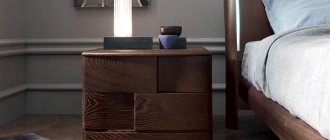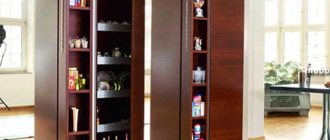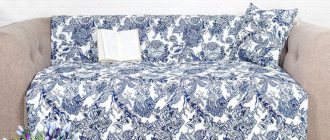10539
Textiles visually create warmth and comfort in any room. The central place in the bedroom is occupied by the sleeping place and it is the quilted bedspread that helps give the interior a harmonious and perfect look. Thanks to a special cape, you can disguise the imperfections of the sleeping place and smooth out sharp corners.
Features of quilted models
Stitching refers to the oldest method of fixing filler between two layers of fabric. Moreover, the stitches are applied to the surface of the bedspread after the cover is filled with a special filler. Stitch lines can be different: parallel, perpendicular, curly. The best option is intersecting seams, since in this case the filler is tightly fixed and it is prevented from moving when using the bedspread or washing it.
Factory products are stitched through the entire area with special sewing machines. Depending on the materials, regular threads (cotton or silk) and thermal stitch are used, which can be used when sewing products from synthetic fabrics. The thermal stitching process is carried out using a special device that precisely melts synthetic fibers.
The main advantages of quilted bedspreads: the products hold their shape well, practically do not wrinkle and have a pleasant aesthetic appearance, are durable and practical. These bedspreads allow you to quickly make the bed and give your sleeping area a neat and well-groomed look.
Preparatory stage
To sew a high-quality bedspread, it is better to use a sewing machine, but you can make the stitches yourself. The sewing technology will not be too different, but in the second case it will take a lot of time, and besides, it is very difficult to make the stitches even by hand.
Related article: How to wash blinds quickly without removing the system?
Bedspread size chart.
First of all, you need to assemble the pie. Place the facing fabric on the floor, wrong side up. Then put a spacer on it, and then a lining. Carefully align all layers, otherwise creases and folds will spoil the final appearance of the product. After this, be sure to secure the structure. The easiest way to do this is with sewing pins and basting.
Pin the edges and secure the center of the future bedspread. After this, decide how you will quilt the piece. For beginners, it is preferable to choose simple patterns, such as rhombuses or squares. After this, use a needle and thread of a contrasting color to outline the pattern of the future stitch. But if you are using fabric that shows puncture marks, such as satin, you should skip this step. Or use a special adhesive tape that is securely attached and serves as a guide. It is easily removed without leaving any traces, just moisten it with water.
After this, you can proceed directly to stitching.
Criterias of choice
Manufacturers use different materials to make bedspreads. Some products can be used as additional blankets. Therefore, when choosing, it is advisable to focus not only on the appearance of the bedspread or the quality of the fabrics. You should also familiarize yourself with the characteristics of the fillers.
Material
The textile variety allows you to choose a bedspread that suits the cost and quality of the fabric. The following materials can be used for sewing:
- natural cotton material makes the bedspreads pleasant to the touch, breathable, and practical. Calico or satin is most often used. Calico has an affordable price, high strength and wear resistance. Satin is also strong and retains its original appearance for a long time. Thanks to the special double weaving of twisted threads, the satin surface acquires a special delicate silky shine, which makes the material refined and gives it an expensive look;
- Linen is durable, wear-resistant, and environmentally friendly. This material is quite dense, holds its shape well and is very pleasant to the touch. Linen bedspreads are easy to care for;
- silk has a special delicacy. With its luxurious and varied designs, a bedspread can become the centerpiece of a room. The undoubted advantages of silk are antibacterial properties and hypoallergenicity. Silk bedspreads do not attract dust. The main disadvantage of textiles is the high price;
- The most commonly used synthetic materials are acrylic and microfiber. Acrylic is elastic, retains color for a long time, and does not require serious care (just wash in cool water). The main disadvantage is that the fibers on the surface can roll off. There are no pellets formed on the microfiber surface and the fabrics “breathe” well.
It is the beautiful front side that makes the bedspread a real decoration for the bedroom. It is important to take into account the style of the room.
Linen
Cotton
Silk
Filler
Manufacturers use both natural and synthetic materials as an intermediate layer:
- wool - this material is attractive due to its lightness, strength, wear resistance, and durability (service life up to 15 years). Wool breathes well and allows the bedspread to air quickly. Camel, sheep, and goat wool is used as filler. Bedspreads made from sheep wool (Australian merino) and goat wool (cashmere) are especially soft. To create a thin, warm layer, the delicate undercoat of cashmere mountain goats is used. Disadvantages include the possibility of an allergic reaction to wool and the need to protect the bedspread from moths;
- silk is optimal for summer bedspreads. The basis of the filler is a high-quality silk variety - Mulberry. Main advantages: environmental friendliness, durability, hypoallergenic. The high cost of products and heavy weight (compared to synthetic fillers) can be attributed to the disadvantages of silk;
- plant fibers (cotton, flax, bamboo) are environmentally friendly, but are considered somewhat exotic. These materials are hypoallergenic, comfortable, easy to care for, and low in price. Bedspreads with such fillings are suitable for any time of year. A special advantage of bamboo filler is its antiseptic properties, eliminating the appearance of dust mites and bacteria;
- Thanks to synthetic fillers (sintepon, polyester fiber), the bedspreads are light. Depending on the density of the filler (100, 200, 300 g/sq m), the product may cost more and look more luxurious.
Many housewives like to change bedspreads depending on the season. For the warm season, cotton bedspreads filled with padding polyester, bamboo, and silk are suitable. On cold winter nights, things with a wool layer will keep you warm.
Lining
For the reverse side of the bedspread, fabrics are selected that are practical and inexpensive:
- calico is a cotton fabric that can include both artificial and natural fibers. For single-sided quilted bedspreads, plain-dyed fabric is used. Positive qualities: low wrinkleability, hygiene, environmental friendliness, lightness, durability;
- viscose – artificial fabric (base – wood cellulose). Main advantages: lighter than cotton, retains color well, does not accumulate static electricity, high strength, hypoallergenic. For quilted bedspreads, viscose is used, which has undergone additional processing, making the fabric stronger;
- mixed materials consist of natural and synthetic fibers. Thanks to the combined composition, the materials are easy to care for, wear-resistant, pleasant to the touch and have an affordable price.
The main requirement for lining fabrics is that they should not be slippery. Otherwise, the quilted bedspread may constantly slide off the bed.
Size
The blanket should freely cover the mattress, but not touch the floor. In order not to make a mistake with your purchase, you need to know the exact dimensions of the bed. The best option is to add approximately 20-25 cm to the allowances on each side of the mattress. So, for a single bed with parameters of 120x200 cm, a bedspread of 160x200 cm or 160x220 cm is suitable (if there is no backrest at the foot of the bed). Approximate sizes of bedspreads based on different bed options:
- single – 140x200x220 cm;
- one and a half – 150/160x200x220 cm;
- double – 180x200x220 cm or 200x220 cm.
According to European standards, quilted bedspreads should hang to the floor and slightly cover the legs of the bed. Therefore, products are sewn with dimensions of 220x240 cm, 230x250 cm or even 270x270 cm.
Some bedspreads can be decorated with frills and flounces. As a rule, the quilted part in the products has the dimensions of a berth, and the frill is sewn to its edges. In order not to make a mistake with the choice, it is advisable to sew such bedspreads to order - then it is easier to determine the length of the frill and the area of the quilted base.
Sew a quilted bedspread
If you use a sewing machine for stitching, make sure that the kit includes a special presser foot for stitching. It ensures a uniform supply of material, which reduces the likelihood of distortions and creases.
All layers must be stitched from the center to the edges.
During each pass of the needle, you need to slightly stretch the fabric with both hands. Single tension hello to thread breakage. After completing each stage, the stitching must be aligned and slightly stretched, making sure that the seam is not damaged. Each new line must be started from the center; this technique allows you to preserve the arrangement of layers as much as possible. After the last stitch has been sewn, straighten the edges of the blanket using sharp scissors and remove the basting. Only then proceed to edge processing.
Related article: Acrylic bathtubs: characteristics, sizes and models
If you are sewing a blanket or bedspread without a frill, you should make the edge according to the following pattern. Take a ribbon to decorate the edge or any wide enough braid. Sew it to the front of the bedspread, carefully tuck the cushioning material inside and stitch it to the lining. This processing method is quite simple and convenient to use.
If you decide to decorate the bedspread with a frill, it is not at all difficult to do this, because the decorative element is single-layer and consists only of the front side fabric. Cut the material taking into account the data obtained during measurement. The width of the frill is the height of the bed. Length - the perimeter of the bedspread, multiplied by 1.5-2, such a margin is necessary for laying beautiful tails.
If you managed to sew a bedspread without defects, making a frill will seem like a simple task. Sew the material evenly with a double seam, laying folds; usually 8-10 cm of distance between them is enough.
Using a similar pattern, you can sew pillowcases or chair covers from leftover fabric. Decorative details made of the same fabric will make the interior stylish and complete.
If you managed to sew a flawless bedspread with your own hands, you can rightfully consider yourself a craftsman. With these skills, you will be able to decorate your home and dacha with other quilted products, because they always look stylish, cozy and relevant.
How to choose the right color and pattern
More often than not, the bedspread plays a big role in the design of the room. In small bedrooms, the bed takes up most of the space, and the same color scheme of textiles and decoration will visually “disguise” the sleeping area. Therefore, laying a bedspread of a similar shade will be a good move for modest-sized rooms.
To prevent the interior from looking too monotonous, the quilted product can stand out somewhat in color. Light brown textiles look good on a beige background, and turquoise textiles in a blue room. It is the appearance of the item that can give the environment a cozy and stylish look. A few design tips will help you decide on the choice of quilted bedspread:
- It is important to consider the overall temperature of the room. Orange, yellow or red bedspreads will create a warm coziness in rooms with windows facing north. And blue, silver shades of textiles will bring a cool mood to a bedroom with windows facing south;
- A classic technique is to select bedspreads and curtains of the same color and pattern. Not everyone will like such a conservative decision. However, it is difficult to argue that the interior in this case turns out harmonious and calm;
- For spacious double beds, textiles in dark shades are better suited, but for single beds - light ones;
- if the bedspread should become a decoration of the room, then bright products with catchy patterns are chosen. This technique is justified in rooms of pastel or neutral shades. How to choose contrasts is a matter of taste. A blue bedspread with a silver pattern will create an atmosphere of elegance and calm in a light green bedroom. Yellow textiles with golden ornaments will look elegant and luxurious in white rooms;
- For a children's bedroom, fabric with bright pictures is selected (uniform arrangement of fruits, geometric shapes). Bedspreads with interesting ethnic patterns and small patterns are suitable for an adult bedroom. A great option for any room is checkered, striped or polka dot materials.
For a Provencal style bedroom, sandy, pale pink fabrics with small floral patterns are suitable. For Baroque rooms, you should look for silk fabrics with ornate golden patterns. For modern recreation rooms, plain products quilted with small checks are suitable.
An excellent economical option for lovers of variety is a combined double-sided bedspread. In such products, both sides are used as front sides. Moreover, the fabrics can be of contrasting shades or differ in the quality of the material.
Choosing the right bedspread will help create an atmosphere of relaxation and tranquility in the room. Textiles in the interior not only support style, but also reflect the preferences of the owners and their preferences.
Taking measurements and cutting material
A quilted bedspread in the bedroom hides all the unevenness, so the room will always look neat.
In order to be pleased with the result of your work, it is important to be careful at every stage of sewing. Choose the model of your future textile accessory. Bedspreads with a frill along the bottom edge look especially attractive; often it is this detail that makes them charming.
Related article: How to get rid of grease stains on curtains
First of all, you need to correctly take measurements of the furniture so that the bedspread does not turn out to be too small. This precaution is due to the fact that during the firmware process the dimensions of the product may decrease. To purchase enough material, you need to measure the length, height and width of the bed and the corners. If there are no problems with the first three measurements, then the corners may be driven into a dead end. The best solution would be to place a sheet of paper on the surface, transfer the outlines onto it and carefully cut it out, so you will get a finished pattern.
After taking measurements, add 1-2 cm to each indicator in addition to allowances for seams and processing - a reserve in case of shrinkage of the material. When calculating the length of the frill, keep in mind that a gap of 2-3 cm between the floor and the edge of the bedspread makes the bed visually higher and greatly simplifies the process of cleaning the room.
So, the measurements have been taken, you can start cutting out the parts. To avoid force majeure during the sewing process, follow the recommendations:
- The fabric for the front layer is cut in accordance with the measurements taken with the addition of 2-3 cm for processing and 1-2 cm for shrinkage during stitching.
- Cut out the cushioning material, focusing on the dimensions of the front fabric. It is important to leave a margin of 1-2 cm on each side. This will insure you against unpleasant surprises if during the sewing process the padding polyester shrinks due to stitching. Excess can always be removed during operation.
- The size of the lining should always be 5 cm larger than the front part. This reserve will ensure flawless processing of seams and frill abutment lines.











